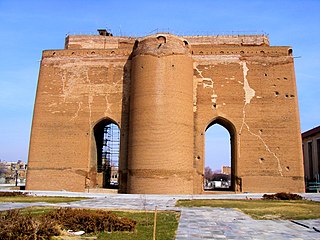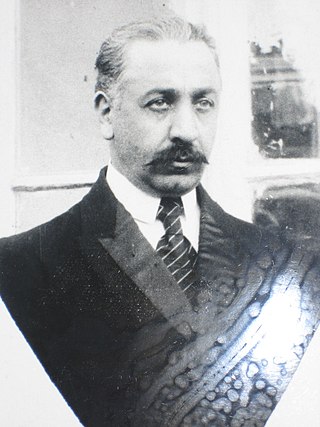See also
Districts of Tabriz | ||
|---|---|---|
| ||
| | This Tabriz County location article is a stub. You can help Wikipedia by expanding it. |
Gajil is an ancient and historical district in Tabriz. The district is mainly famous for having one of the major gates of the older Tabriz in ancient times. In Pahlavi period, Golestan Park, is constructed in part of the Gajil district, which was previously used as a cemetery.

Tabriz is a city in the Central District of Tabriz County, in the East Azerbaijan province of northwestern Iran. It serves as capital of the province, the county, and the district. It is the sixth-most-populous city in Iran.

Golestan province is one of the 31 provinces of Iran, located in the northeast of the country and southeast of the Caspian Sea. Its capital is the city of Gorgan, formerly called Esterabad until 1937. Golestan was split off from Mazandaran Province in 1997.

Arg of Tabriz, is the remnants of a large acropolis fortification and city wall in downtown Tabriz, Iran. Its structure is visible from far distances in downtown Tabriz, if not blocked by the newly erected highrise buildings.
Gulistan, Golestan or Golastan means "flower land" in Persian language.

A Tabriz rug or carpet is a type in the general category of Persian carpets from the city of Tabriz, the capital city of East Azerbaijan province in northwest of Iran. It is one of the oldest rug weaving centers and makes a huge diversity of types of carpets. The range starts at Bazaar quality of 24 raj and on up to the incredibly fine 110 raj. Raj is the unit of knot density. It shows the rigidity of the rug which based on the number of strings used for the foundation of the rug. Strings materials are usually made of cotton or silk which is used for very fine rugs.

Gonbad-e Kavus is a city in the Central District of Gonbad-e Kavus County, Golestan Province, Iran, serving as capital of both the county and the district.
Shabestar is a city in the Central District of Shabestar County, East Azerbaijan province, Iran, serving as capital of both the county and the district.
The Tabriz Central Library, formerly Tabriz National Library, was founded in 1956 by Hajj Mohammad Nakhjavani with help from the people of Tabriz, Iran. It contains several handwritten books. The library is called National because of its non-benefit and non-governmental structure. Initially the library started by the books which are gathered by people specially by Nakhjavani, the building also constructed without any government investment.

El Goli, also called Shah Goli is a large historic park in the south east region of Tabriz, Iran. One of its main features is its large artificial lake, measuring approximately 55.000 m2/592.015 ft square.
Shahabad may refer to:

Golestan Park is a park in Tabriz, Iran. The place, which was originally used as a public cemetery, was changed to a city park during the second Pahlavi era. A marble clock tower, which has been devastated recently, had been founded at the front of main entrance of the park.
This is a list of visitor attractions of Tabriz, Iran.
Foggy Tabriz is an Iranian historical drama television series directed by Mohammad-Reza Varzi. It ran for one season with 28 episodes. It was one of the first flagship series to air on iFilm.
Qaraghaj is a historic and ancient district in the eastern part of Tabriz. Qaraghaj means "Elm tree" in the Azerbaijani language. Qaraghaj district is bordered by Viji Bashi and Hokmavar districts in north, Kuchabagh district in south, Gajil district in east and Akhini district in west.

The 2013–14 Hazfi Cup was the 27th season of the Iranian football knockout competition. Sepahan was the defending champion, but was eliminated by Sanat Naft in the Round of 32. The competition started on 4 September 2013 and ended on 14 February 2014. Tractor won the title, defeating Mes Kerman in the final.

Mohammad Ali Tarbiat was an Iranian revolutionary, politician and reformist. He founded the Tarbiat library which was the first library in Iran. Tarbiat was a writer active in the Iranian Constitutional Revolution and a member of the National Consultative Assembly from the electorate of Tabriz (1931-1940).
Baba Faraj Tabrizi was an Iranian Sufi shaykh ("master") of the 12th century. He is also known as Gajili, due to his khaniqah and tomb being situated in the Gajil district of Tabriz.